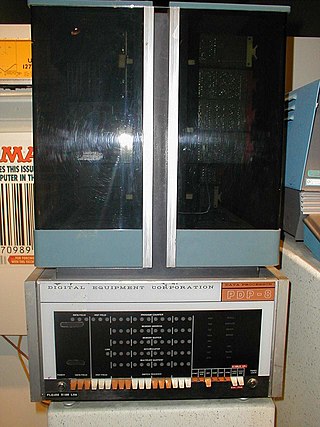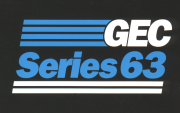
Digital Equipment Corporation, using the trademark Digital, was a major American company in the computer industry from the 1960s to the 1990s. The company was co-founded by Ken Olsen and Harlan Anderson in 1957. Olsen was president until forced to resign in 1992, after the company had gone into precipitous decline.

A minicomputer, or colloquially mini, is a class of smaller general purpose computers that developed in the mid-1960s and sold at a much lower price than mainframe and mid-size computers from IBM and its direct competitors. In a 1970 survey, The New York Times suggested a consensus definition of a minicomputer as a machine costing less than US$25,000, with an input-output device such as a teleprinter and at least four thousand words of memory, that is capable of running programs in a higher level language, such as Fortran or BASIC.

The PDP-11 is a series of 16-bit minicomputers sold by Digital Equipment Corporation (DEC) from 1970 into the late 1990s, one of a set of products in the Programmed Data Processor (PDP) series. In total, around 600,000 PDP-11s of all models were sold, making it one of DEC's most successful product lines. The PDP-11 is considered by some experts to be the most popular minicomputer.

VAX is a series of computers featuring a 32-bit instruction set architecture (ISA) and virtual memory that was developed and sold by Digital Equipment Corporation (DEC) in the late 20th century. The VAX-11/780, introduced October 25, 1977, was the first of a range of popular and influential computers implementing the VAX ISA. The VAX family was a huge success for DEC – over 100 models were introduced over the lifetime of the design, with the last members arriving in the early 1990s. The VAX was succeeded by the DEC Alpha, which included several features from VAX machines to make porting from the VAX easier.

HP-UX is Hewlett Packard Enterprise's proprietary implementation of the Unix operating system, based on Unix System V and first released in 1984. Current versions support HPE Integrity Servers, based on Intel's Itanium architecture.

Computer operating systems (OSes) provide a set of functions needed and used by most application programs on a computer, and the links needed to control and synchronize computer hardware. On the first computers, with no operating system, every program needed the full hardware specification to run correctly and perform standard tasks, and its own drivers for peripheral devices like printers and punched paper card readers. The growing complexity of hardware and application programs eventually made operating systems a necessity for everyday use.

Xenix is a discontinued version of the Unix operating system for various microcomputer platforms, licensed by Microsoft from AT&T Corporation in the late 1970s. The Santa Cruz Operation (SCO) later acquired exclusive rights to the software, and eventually replaced it with SCO UNIX.
General Comprehensive Operating System is a family of operating systems oriented toward the 36-bit GE/Honeywell mainframe computers.
This article presents a timeline of events in the history of computer operating systems from 1951 to the current day. For a narrative explaining the overall developments, see the History of operating systems.
Aviion was a series of computers from Data General that were the company's main product from the late 1980s until the company's server products were discontinued in 2001. Earlier Aviion models used the Motorola 88000 CPU, but later models moved to an all-Intel solution when Motorola stopped work on the 88000 in the early 1990s. Some versions of these later Intel-based machines ran Windows NT, while higher-end machines ran the company's flavor of Unix, DG/UX.
Pyramid Technology Corporation was a computer company that produced a number of RISC-based minicomputers at the upper end of the performance range. It was based in the San Francisco Bay Area of California

Unix System V is one of the first commercial versions of the Unix operating system. It was originally developed by AT&T and first released in 1983. Four major versions of System V were released, numbered 1, 2, 3, and 4. System V Release 4 (SVR4) was commercially the most successful version, being the result of an effort, marketed as Unix System Unification, which solicited the collaboration of the major Unix vendors. It was the source of several common commercial Unix features. System V is sometimes abbreviated to SysV.

The PERQ, also referred to as the Three Rivers PERQ or ICL PERQ, was a pioneering workstation computer produced in the late 1970s through the early 1980s. In June 1979, the company took its very first order from the UK's Rutherford Appleton Laboratory and the computer was officially launched in August 1979 at SIGGRAPH in Chicago. It was the first commercially produced personal workstation with a Graphical User Interface. The design was heavily influenced by the original workstation computer, the Xerox Alto, which was never commercially produced. The origin of the name "PERQ" was chosen both as an acronym of "Pascal Engine that Runs Quicker," and to evoke the word perquisite commonly called perks, that is employee additional benefits.

The Professional 325 (PRO-325), Professional 350 (PRO-350), and Professional 380 (PRO-380) are PDP-11 compatible microcomputers introduced in 1982 by Digital Equipment Corporation (DEC) as high-end competitors to the IBM PC.

Am2900 is a family of integrated circuits (ICs) created in 1975 by Advanced Micro Devices (AMD). They were constructed with bipolar devices, in a bit-slice topology, and were designed to be used as modular components each representing a different aspect of a computer control unit (CCU). By using the bit slicing technique, the Am2900 family was able to implement a CCU with data, addresses, and instructions to be any multiple of 4 bits by multiplying the number of ICs. One major problem with this modular technique was that it required a larger number of ICs to implement what could be done on a single CPU IC. The Am2901 chip was the arithmetic logic unit (ALU), and the "core" of the series. It could count using 4 bits and implement binary operations as well as various bit-shifting operations.

The Sony NEWS is a series of Unix workstations sold during the late 1980s and 1990s. The first NEWS machine was the NWS-800, which originally appeared in Japan in January 1987 and was conceived as a desktop replacement for the VAX series of minicomputers.

The GEC 4000 was a series of 16/32-bit minicomputers produced by GEC Computers Ltd in the United Kingdom during the 1970s, 1980s and early 1990s.
OS4000 is a proprietary operating system introduced by GEC Computers Limited in 1977 as the successor to GEC DOS, for its range of GEC 4000 series 16-bit, and later 32-bit, minicomputers. OS4000 was developed through to late 1990s, and has been in a support-only mode since then.

GEC Computers Limited was a British computer manufacturing company under the GEC holding company from 1968 until the 1990s.













